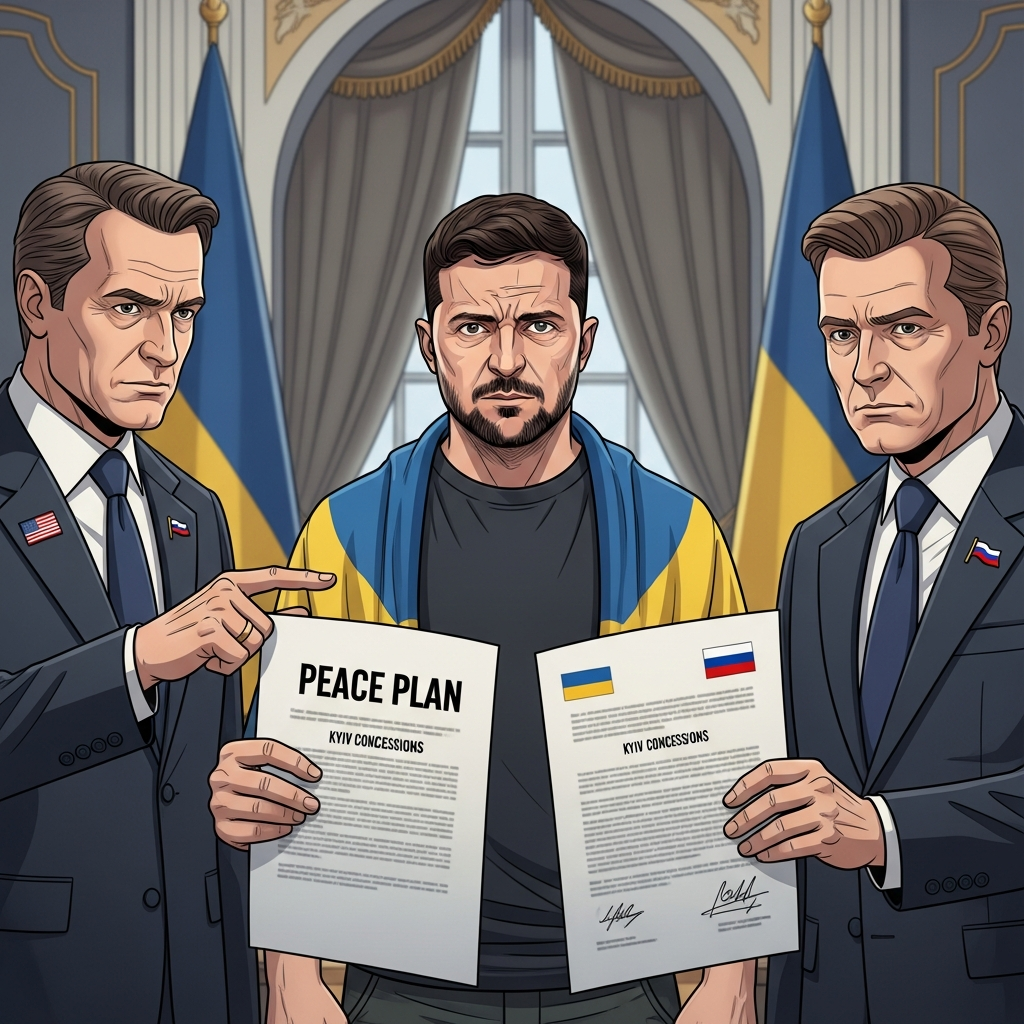A seismic shift in the nearly four-year Ukraine conflict appears underway as reports confirm a joint U.S.-Russia peace framework, demanding significant concessions from Kyiv. This audacious proposal, quietly crafted by top American envoys, places immense pressure on Ukrainian President Volodymyr Zelenskyy, who faces a formidable domestic corruption crisis alongside ongoing military challenges. While hailed by Washington as a pathway to ending the bloodshed, the plan has blindsided European allies and ignited a fierce debate over Ukraine’s sovereignty and future.
Controversial Terms: What Ukraine May Be Forced to Give Up
At the heart of the emerging peace framework are provisions that would fundamentally alter Ukraine’s territorial integrity and defensive capabilities. The blueprint, detailed by insiders, reportedly mandates Kyiv to cede substantial territory to Russia. Specifically, it calls for Moscow to gain effective control over the entire eastern Donbas region, Ukraine’s industrial heartland comprising the Donetsk and Luhansk areas. This aligns precisely with Russian President Vladimir Putin’s stated primary objective since the full-scale invasion commenced in February 2022.
In addition to territorial losses, the proposal also suggests Ukraine abandon specific types of weaponry, potentially weakening its long-term defense posture. For a nation that has fiercely resisted aggression for years, these stipulations represent a profound challenge. President Zelenskyy has consistently and emphatically ruled out any territorial concessions, a stance deeply rooted in Ukraine’s constitution, which renders such ceding illegal and would be profoundly unpopular with its citizens.
Moscow’s Stated “Concessions” and Economic Promises
While the demands on Ukraine are explicit, the reported “concessions” from Moscow appear less concrete. The framework includes promises from Russia to cease further attacks, a point White House officials present as a significant gesture from Putin. Given Putin’s historical narrative—that Ukraine was an artificially created state—any commitment to halt aggression could be viewed as a shift.
The plan also reportedly incorporates economic incentives for both warring nations. The precise nature and scale of these incentives remain unclear, but they aim to sweeten a deal that otherwise places a heavy burden on Kyiv. Such economic carrots might include reconstruction aid or the lifting of certain sanctions, though specifics are scant.
Behind the Diplomatic Curtain: US Efforts and Trump’s Support
The U.S. diplomatic effort, described as a month-long, discreet initiative, has been spearheaded by key figures within the Trump administration. White House press secretary Karoline Leavitt confirmed that Secretary of State Marco Rubio and U.S. special envoy Steve Witkoff have been diligently working on the peace plan. They have reportedly engaged with both Ukrainian and Russian representatives to identify mutually acceptable terms for a “lasting and durable peace.”
President Donald Trump has been briefed on the evolving proposal and reportedly lends his full support. Leavitt characterized the framework as “a good plan for both Russia and Ukraine,” expressing confidence in its potential acceptance by both sides. This push for peace aligns with Trump’s stated objective to resolve the conflict and end the significant human suffering.
U.S. Army Secretary Dan Driscoll also journeyed to Kyiv, meeting with President Zelenskyy to assess the on-the-ground reality and advance peace discussions. Zelenskyy acknowledged these talks, confirming discussions on “options for achieving real peace” and signaling Ukraine’s readiness for “constructive, honest and swift work” with U.S. teams. His office anticipates further diplomatic conversations with President Trump in the coming days.
Key Architects of the Proposal
The drafting of this sensitive proposal has involved close collaboration between U.S. and Russian envoys. Special Envoy Steve Witkoff, a real estate developer who has transitioned into a diplomatic role, is identified as a central figure from the American side. On the Russian front, Kirill Dmitriev, a close advisor to President Putin, has been instrumental in shaping the framework. Their joint efforts underscore the back-channel nature of these high-stakes negotiations, which have remained largely out of the public eye until now.
Kyiv’s Dilemma: Pressure, Corruption, and Constitutional Hurdles
The emergence of this U.S.-Russia peace plan arrives at a particularly challenging moment for President Zelenskyy. He is navigating a major domestic corruption scandal that poses the most significant threat to his government since the full-scale invasion. Public outrage over corruption could weaken his political standing, making it even harder to accept unpopular peace terms.
Simultaneously, Zelenskyy remains steadfast in marshaling Ukraine’s defenses against Russia’s larger military and tirelessly seeks to secure continued European and international support. The constitutional implications of ceding territory are immense, creating a formidable legal and political barrier to any such agreement. Ukrainian officials have repeatedly stated that surrendering land would be both illegal and a betrayal of the sacrifices made by its people.
European Allies Blindsided: Demands for Consultation and Skepticism
The news of a clandestine U.S.-Russia peace plan has sent ripples of alarm and indignation across Europe. European diplomats, caught entirely by surprise, have vociferously insisted on their and Ukraine’s direct involvement in any such negotiations. EU foreign policy chief Kaja Kallas articulated this sentiment, emphasizing, “For any plan to work, it needs Ukrainians and Europeans on board.”
European leaders have long harbored anxieties about being sidelined by the Trump administration, especially given Trump’s occasionally conciliatory posture towards Putin. These concerns were briefly assuaged by recent U.S. sanctions on Russia’s vital oil sector, but the current peace initiative reignites fears of unilateral action.
German Foreign Minister Johannes Wadephul confirmed discussions with Witkoff and Turkish Foreign Minister Hakan Fidan, focusing on efforts to end Russia’s aggression. However, it remains unclear whether these ministers had actually seen the detailed peace plan, further highlighting the lack of transparency surrounding its creation.
Accusations of Russian Insincerity
European diplomats have consistently accused Putin of being disingenuous in his calls for peace. They point to Russia’s continued refusal to compromise in negotiations while relentlessly pursuing its grinding war of attrition, particularly targeting civilian infrastructure. Kaja Kallas cited a recent Russian strike on Ternopil, a western Ukrainian city, which tragically killed 26 and wounded 93, as stark evidence of Russia’s true intentions. She argued that if Russia genuinely desired peace, it could have agreed to an unconditional ceasefire much earlier.
Moscow’s Ambiguous Stance and Battlefield Claims
Adding another layer of complexity, Kremlin spokesman Dmitry Peskov stated that “no consultations per se currently underway” between the U.S. and Russia regarding an end to the war. However, he did acknowledge the existence of “contacts,” leaving room for interpretation regarding the nature and extent of the engagement. This denial, even while U.S. officials confirm the plan’s existence, underscores the delicate and often opaque nature of these top-level diplomatic exchanges.
Meanwhile, on the ground, conflicting reports emerged regarding battlefield control. Russia’s chief military officer, Gen. Valery Gerasimov, claimed significant advances, including full control of Kupiansk in the Kharkiv region, 80% of Vovchansk, and 70% of Pokrovsk in the Donetsk region. These claims, made in a video released by the Kremlin featuring Putin in combat fatigues, depict substantial Russian gains.
However, the Ukrainian general staff swiftly and unequivocally denied all of Gerasimov’s assertions. They maintained that Kupiansk remained firmly under Kyiv’s control, with ongoing efforts to eliminate any enemy presence. This stark divergence in battlefield reporting highlights the persistent information warfare accompanying the conflict, making verification challenging for observers. Kupiansk, a strategically important city, was previously under Russian occupation until a swift Ukrainian offensive liberated it in September 2022.
Implications and the Path Ahead
This proposed peace plan, while aiming to end the conflict, carries profound implications. For Ukraine, it represents an agonizing choice between territorial integrity and an immediate cessation of hostilities. For Europe, it raises concerns about being marginalized in decisions directly impacting regional security. For the global community, it tests the principles of international law and sovereign borders.
The “rollback of some critical U.S. military assistance” to Ukraine, as part of the proposal, also shifts the dynamics of international support. European nations have already stepped up to fill the void created by the cessation of direct U.S. military aid, purchasing weaponry for Ukraine. This has inadvertently given Europe increased leverage in discussions, a factor that cannot be ignored as the diplomatic efforts continue. The path to a lasting peace remains fraught with obstacles, requiring unprecedented diplomatic skill and a willingness from all parties to navigate deeply entrenched positions.
Frequently Asked Questions
What are the core demands of the proposed US-Russia Ukraine peace plan?
The emerging peace plan reportedly requires Ukraine to make significant concessions, including ceding territory to Russia. Specifically, Russia would gain effective control over the entire eastern Donbas region, comprising the Donetsk and Luhansk areas. The plan also calls for Ukraine to abandon certain types of weaponry and involves a rollback of some critical U.S. military assistance. In return, Moscow has promised to cease further attacks and economic incentives are included for both sides.
How has the European Union reacted to the reported peace initiative?
European diplomats were reportedly “blindsided” by the U.S.-Russia peace plan and have strongly insisted on their and Ukraine’s direct consultation. EU foreign policy chief Kaja Kallas stressed that any workable plan needs “Ukrainians and Europeans on board.” European leaders also expressed skepticism about Russia’s sincerity, citing continued attacks on Ukrainian civilian infrastructure and arguing that Russia could have agreed to an unconditional ceasefire much earlier if it genuinely desired peace.
Why is President Zelenskyy under significant pressure regarding this peace proposal?
President Zelenskyy faces immense pressure due to several converging factors. He is concurrently managing Ukraine’s defense against Russia, seeking sustained European support, and dealing with a major domestic corruption scandal that has fueled public outrage. Accepting the proposed peace terms, particularly the cession of territory, would be deeply unpopular with Ukrainians and is illegal under Ukraine’s constitution, a possibility Zelenskyy has repeatedly ruled out.
Conclusion: A Precarious Diplomatic Balancing Act
The revelation of a U.S.-Russia peace plan demanding substantial Ukrainian concessions marks a critical juncture in the ongoing conflict. It highlights a complex diplomatic landscape where the urgent need for peace clashes with principles of sovereignty and justice. President Zelenskyy faces an unenviable task, balancing national defense, domestic political challenges, and intense international pressure. The response from European allies underscores the necessity of a unified front for any sustainable resolution. As negotiations continue behind closed doors, the world watches to see if this controversial framework can indeed pave the way to peace, or if it will simply ignite further discord.



